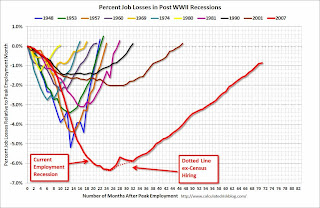by Calculated Risk on 2/02/2014 09:35:00 AM
Sunday, February 02, 2014
Fannie Mae: Mortgage Serious Delinquency rate declined in December, Lowest since November 2008
Fannie Mae reported Friday that the Single-Family Serious Delinquency rate declined in December to 2.38% from 2.44% in November. The serious delinquency rate is down from 3.29% in December 2012, and this is the lowest level since November 2008.
The Fannie Mae serious delinquency rate peaked in February 2010 at 5.59%.
Last week, Freddie Mac reported that the Single-Family serious delinquency rate declined in December to 2.39% from 2.43% in November. Freddie's rate is down from 3.25% in December 2012, and is at the lowest level since February 2009. Freddie's serious delinquency rate peaked in February 2010 at 4.20%.
Note: These are mortgage loans that are "three monthly payments or more past due or in foreclosure".
 Click on graph for larger image
Click on graph for larger image
The Fannie Mae serious delinquency rate has fallen 0.91 percentage points over the last year, and at that pace the serious delinquency rate will be under 1% in about eighteen months. Note: The "normal" serious delinquency rate is under 1%.
Maybe serious delinquencies will be back to normal in late 2015 or 2016.
Saturday, February 01, 2014
Goldman and Merrill on January Employment Report
by Calculated Risk on 2/01/2014 02:28:00 PM
Here are some excepts from two research reports ... first, from Goldman Sachs chief economist Jan Hatzius
Our preliminary forecast for the nonfarm payroll report is a bounceback to a 200,000 pace of increase. There are two key reasons why we expect the report to look strong ... Better weather (yes, really). Although the month of January as a whole was quite cold, the payroll survey week was actually somewhat warmer than normal ... Even excluding the weather impact, the December employment gain looks to be about 50,000 below the recent trend. In our view, this is implausibly weak relative to other job market measures ... This could result in a bounceback to an above-trend pace even outside the weather impact, although it is also possible that the December reading will be revised up.From Ethan Harris at Merrill Lynch:
... we see a drop in the unemployment rate from 6.7% to 6.6%, partly because the expiration of emergency unemployment benefits at yearend may have caused another drop in labor force participation and partly because we expect a good increase in household employment, which has likewise underperformed job market indicators such as claims.
We forecast nonfarm payrolls to increase 185,000, an improvement from the 74,000 gain in December, but still somewhat below the recent trend. The unemployment rate is likely to slip to 6.6% from 6.7%.From CR: At Harris notes, the annual benchmark revision will be released with the January employment report, and the preliminary estimate is an upward revision of 345,000 jobs, however the revision would have been negative except for the reclassification of certain jobs (that weren't previously included in the payroll report).
Typically when poor weather conditions result in a downward bias to payroll growth, there will be a positive reversal the subsequent month when those “missing” payrolls reappear on the books. Although job growth was held back in December by the harsh weather, we do not think a strong snap-back will occur in January. ... On balance, the weather in January was worse than normal, which would depress activity. While conditions improved for the survey week (since the 12th falls on a Sunday, the pay period is the week of the 13th), the rest of the month was quite cold. In particular, the week prior experienced the "polar vortex."
...
The benchmark revision to nonfarm payrolls will also be released along with this report. The preliminary revision was for an upward revision of 345,000, or 0.3% of payrolls. This will impact the data from April 2012 through March 2013.
On the weather, it is uncertain. It was very cold in many parts of the country during January, but the weather during the survey week was decent for January. So the weather impact might be minimal.
I'll write an employment report preview later this week after more data for January is released.
Schedule for Week of Feb 2nd
by Calculated Risk on 2/01/2014 11:15:00 AM
This will be a busy week for economic data with several key reports including the January employment report on Friday.
Other key reports include the ISM manufacturing index on Monday, January vehicle sales also on Monday, the ISM service index on Wednesday, and the December trade deficit report on Thursday.
 All day: Light vehicle sales for January. The consensus is for light vehicle sales to increase to 15.7 million SAAR in January (Seasonally Adjusted Annual Rate) from 15.3 million SAAR in December.
All day: Light vehicle sales for January. The consensus is for light vehicle sales to increase to 15.7 million SAAR in January (Seasonally Adjusted Annual Rate) from 15.3 million SAAR in December.This graph shows light vehicle sales since the BEA started keeping data in 1967. The dashed line is the December sales rate.
9:00 AM ET: The Markit US PMI Manufacturing Index for January. The consensus is for a decrease to 53.9 from 55.0 in December.
 10:00 AM ET: ISM Manufacturing Index for January. The consensus is for a decrease to 56.0 from 57.0 in December.
10:00 AM ET: ISM Manufacturing Index for January. The consensus is for a decrease to 56.0 from 57.0 in December.Here is a long term graph of the ISM manufacturing index.
The ISM manufacturing index indicated expansion in December at 57.0%. The employment index was at 56.9%, and the new orders index was at 64.2%.
10:00 AM: Construction Spending for December. The consensus is for no change in construction spending.
10:00 AM: Manufacturers' Shipments, Inventories and Orders (Factory Orders) for December. The consensus is for a 1.8% decrease in December orders.
10:00 AM: The Congressional Budget Office will release its annual Budget and Economic Outlook. The report will include updated economic and budget projections spanning the period from 2014 to 2024.
7:00 AM: The Mortgage Bankers Association (MBA) will release the results for the mortgage purchase applications index.
8:15 AM: The ADP Employment Report for January. This report is for private payrolls only (no government). The consensus is for 170,000 payroll jobs added in January, down from 238,000 in December.
10:00 AM: ISM non-Manufacturing Index for January. The consensus is for a reading of 53.9, up from 53.0 in December. Note: Above 50 indicates expansion, below 50 contraction.
Early: Trulia Price Rent Monitors for January. This is the index from Trulia that uses asking house prices adjusted both for the mix of homes listed for sale and for seasonal factors.
8:30 AM: The initial weekly unemployment claims report will be released. The consensus is for claims to decrease to 337 thousand from 348 thousand.
 8:30 AM: Trade Balance report for December from the Census Bureau.
8:30 AM: Trade Balance report for December from the Census Bureau. Imports decreased, and exports increased in November.
The consensus is for the U.S. trade deficit to increase to $36.0 billion in December from $34.3 billion in November.
8:30 AM: Employment Report for January. The consensus is for an increase of 181,000 non-farm payroll jobs in January, up from the 74,000 non-farm payroll jobs added in December.
The consensus is for the unemployment rate to be unchanged at 6.7% in January.
The following graph shows the percentage of payroll jobs lost during post WWII recessions through December.
 The economy has added 8.2 million private sector jobs since employment bottomed in February 2010 (7.6 million total jobs added including all the public sector layoffs).
The economy has added 8.2 million private sector jobs since employment bottomed in February 2010 (7.6 million total jobs added including all the public sector layoffs).There are still almost 640 thousand fewer private sector jobs now than when the recession started in 2007.
3:00 PM: Consumer Credit for December from the Federal Reserve. The consensus is for credit to increase $12.0 billion in December.
Unofficial Problem Bank list declines to 590 Institutions
by Calculated Risk on 2/01/2014 08:11:00 AM
This is an unofficial list of Problem Banks compiled only from public sources.
Here is the unofficial problem bank list for January 31, 2014.
Changes and comments from surferdude808:
The FDIC released its enforcement action activity through year-end 2013, which contributed to many changes to the Unofficial Problem Bank List. For the week, there were 10 removals and one addition that leave the list at 590 institutions with assets of $195.4 billion. A year ago, the list held 822 institutions with assets of $308 billion. During the month, the list declined by a net of 29 institutions and assets dropped by $18.1 billion. This was the largest net monthly decline in the number of institutions and assets since the list was first published. While the 19 action terminations during the month were above average, there are well below the monthly high of 25 terminations during April 2012. Thus, mergers, failures, and voluntary liquidations contributed to the 31 removals during the month.
Syringa Bank, Boise, ID ($34 million Ticker: SGBP) failed this week making it the second failure in Idaho since the on-set of the Great Recession. This is third consecutive week for a failure, which has not occurred since late October/early November 2012. Midwest Federal Savings and Loan Association of St Joseph, Saint Joseph, MO ($33 million Ticker: SJBA) found a merger partner to exit the list.
Actions were terminated against Falcon International Bank, Laredo, TX ($817 million); Community West Bank, National Association, Goleta, CA ($532 million); BankCherokee, Saint Paul, MN ($262 million); Sanibel Captiva Community Bank, Sanibel, FL ($228 million); Columbia Bank, Lake City, FL ($190 million); Peoples Bank, Clifton, TN ($135 million); Sunrise Bank, Cocoa Beach, FL ($107 million); Woodland Bank, Deer River, MN ($66 million); and Farmers State Bank of Sublette, Sublette, IL ($43 million).
The sole addition this week is Vantage Point Bank, Horsham, PA ($75 million).
Over the next two weeks, we expect for there to be only a few changes to the list as the OCC will likely not release an update until February 21st. By the end of the month, the FDIC should release fourth quarter industry results and provide an update to the official figures.
Enjoy the Super Bowl or at least the advertisements should your favorite fail to win.
Friday, January 31, 2014
Bank Failure #3 in 2014: Syringa Bank, Boise Idaho
by Calculated Risk on 1/31/2014 08:46:00 PM
From the FDIC: Sunwest Bank, Irvine, California, Assumes All of the Deposits of Syringa Bank, Boise Idaho
As of September 30, 2013, Syringa Bank had approximately $153.4 million in total assets and $145.1 million in total deposits. ... The FDIC estimates that the cost to the Deposit Insurance Fund (DIF) will be $4.5 million. ... Syringa Bank is the 3rd FDIC-insured institution to fail in the nation this year, and the first in Idaho.Still closing banks, just fewer this year ... and this was a pretty small hit to the DIF.


